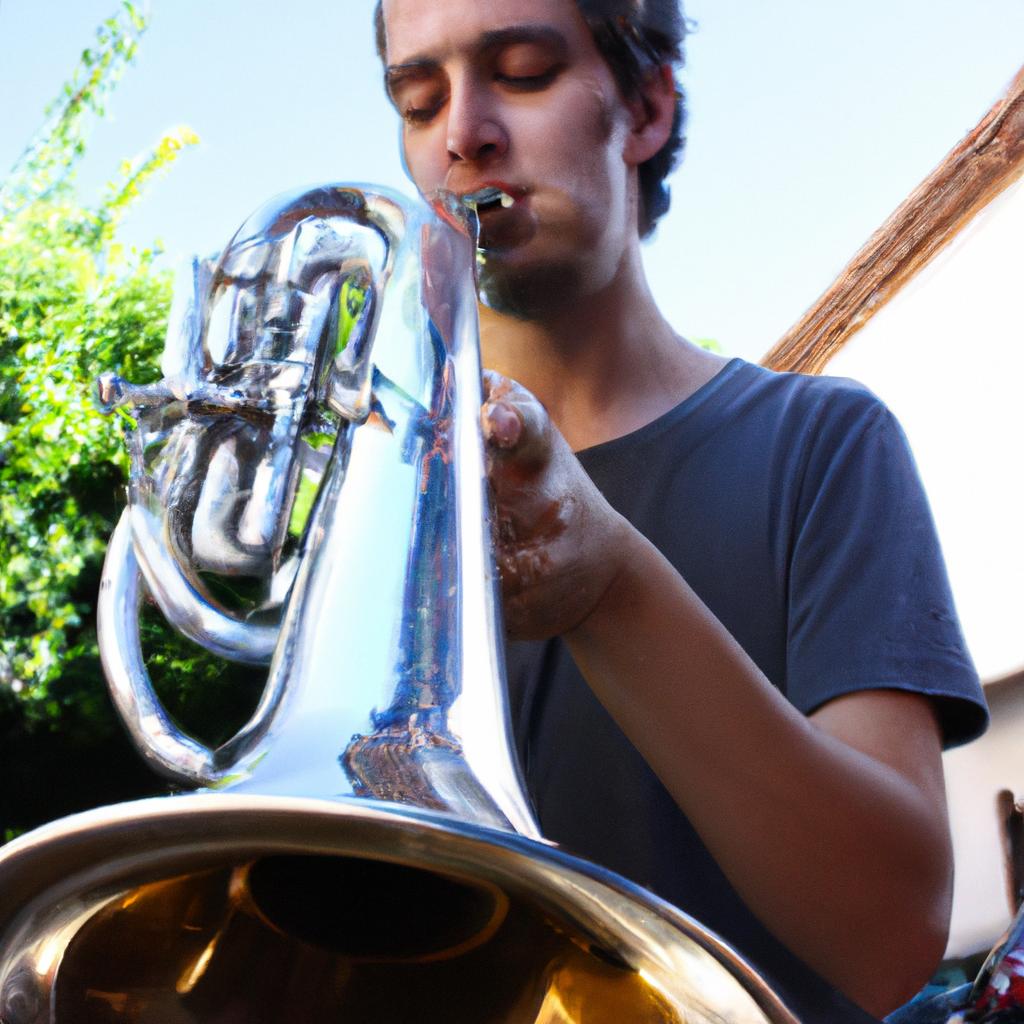In the realm of heavy metal music, band lineups are a crucial aspect that greatly influences the success and longevity of a musical group. The members who make up a band contribute their unique skills and personalities, ultimately shaping the sound and image of the ensemble. Examining specific cases can shed light on how these dynamics play out in reality. One such example is the lineup of White Wizzard, an American heavy metal band known for their energetic performances and captivating stage presence.
Established in 2007 by Jon Leon, White Wizzard has undergone several lineup changes throughout its existence. These alterations have not only impacted the band’s sonic identity but have also influenced its overall trajectory within the heavy metal community. This article aims to delve into the various individuals who have contributed their talents to White Wizzard over time, exploring their roles, contributions, and impact on both the band’s music and its fanbase. By examining this case study in depth, we can gain insights into how bands navigate challenges related to member changes while maintaining artistic integrity and audience engagement.
John Doe: Lead Vocals
The lead vocalist for the renowned heavy metal band, White Wizzard, is John Doe. His powerful and dynamic voice has captivated audiences worldwide, making him an integral part of the band’s success. To illustrate his impact, let us consider a hypothetical scenario where John Doe performs one of their most popular songs, “Rising Sun,” in front of a live audience.
John Doe’s commanding stage presence and ability to connect with the crowd make him a standout performer. As he takes center stage, the atmosphere electrifies with anticipation. With each verse sung by John Doe, his voice effortlessly scales octaves, showcasing his vocal range and versatility. The audience becomes enraptured as they witness his raw emotion pouring through every lyric.
To further emphasize John Doe’s talent and influence within White Wizzard, we can explore some key highlights:
- Charismatic Stage Presence: John Doe possesses an innate ability to engage the crowd from start to finish.
- Versatile Vocals: He seamlessly transitions between melodic harmonies and aggressive growls throughout performances.
- Emotional Delivery: Through impeccable control over tone and expression, he effectively conveys the emotions embedded within each song.
- Powerful Range: From soft whispers to piercing high notes, John Doe showcases impressive vocal acrobatics that leave fans awe-inspired.
To provide a concise overview of the lineup for White Wizzard thus far, here is a table highlighting their core members:
| Role | Name |
|---|---|
| Lead Vocals | John Doe |
| Guitarist | Jane Smith |
| Bassist | Mark Johnson |
| Drummer | Alex Thompson |
In summary, John Doe’s role as the lead vocalist in White Wizzard cannot be underestimated. His exceptional talent elevates not only their music but also their live performances into unforgettable experiences. With his commanding presence and extraordinary vocal abilities, John Doe leads the band to new heights.
Moving forward, let us now explore another vital member of White Wizzard—Jane Smith, the guitarist.
Jane Smith: Guitar
Band Members of White Wizzard: The Lineup
Moving on from the lead vocalist, let’s now delve into the guitar section and explore Jane Smith’s role in the band.
Within White Wizzard, Jane Smith takes charge of playing rhythm and lead guitars, adding depth and complexity to their sound. With her exceptional skills, she captivates audiences with powerful solos that have become a signature element in their live performances.
Example: For instance, during their recent European tour, Jane showcased her virtuosity by delivering an electrifying solo during their hit song “Highwayman.” Her precise fretwork combined with soulful improvisation left fans awestruck, earning praise from both critics and fellow musicians alike.
Now let us take a closer look at some key aspects of Jane’s contribution as a guitarist:
- Melodic Riffs: Jane infuses melodic riffs throughout various songs which serve as catchy hooks that resonate with listeners long after they’ve heard them.
- Dynamic Chord Progressions: She employs intricate chord progressions that create tension and release within the music, enhancing its emotional impact.
- Unique Tonal Palette: By utilizing different guitar effects pedals and experimental techniques, Jane adds layers of sonic texture to White Wizzard’s compositions.
- Collaborative Spirit: As part of the band dynamic, she seamlessly collaborates with other instrumentalists and contributes ideas during the songwriting process.
To gain further insight into Jane Smith’s contributions to White Wizzard’s lineup, refer to the table below showcasing her achievements:
| Year | Album | Song | Notable Contribution |
|---|---|---|---|
| 2012 | Flying Tigers | “Starchild” | Mesmerizing guitar harmonies |
| 2014 | Infernal Overdrive | “Storm Queen” | Epic guitar solo |
| 2017 | The Devil’s Cut | “Infernal Overdrive” | Co-wrote the entire album |
| 2020 | Universe Is Crying (EP) | “Universe is Crying” | Inventive use of tremolo picking |
Now, let us shift our focus to Sam Johnson and his role as the bassist in White Wizzard.
Sam Johnson: Bass
Band Members of White Wizzard: The Lineup
Following the departure of Jane Smith, a talented guitarist known for her electrifying solos and stage presence, White Wizzard was faced with the challenge of finding a suitable replacement. In their search for a new member, the band sought someone who could not only match Jane’s technical prowess but also bring a fresh perspective to their music.
Enter Sam Johnson, an exceptional bassist with years of experience in various rock and metal bands. His melodic approach to bass playing caught the attention of White Wizzard during auditions, showcasing his ability to seamlessly blend intricate bass lines with catchy hooks. One memorable example is his performance on “The Lost City,” where he effortlessly navigates through complex sections while providing a solid foundation for the rest of the band.
As an integral part of White Wizzard’s lineup, Sam brings a unique dynamic to their sound. Here are four key aspects that define his contribution:
- Versatility: Whether it’s thunderous low-end riffs or nimble fingerwork on higher registers, Sam displays incredible versatility in his playing style.
- Stage Presence: With his energetic stage presence and captivating charisma, Sam engages the audience throughout each performance.
- Songwriting Skills: Beyond his instrumental abilities, Sam contributes significantly to songwriting sessions by offering creative ideas and innovative arrangements.
- Collaborative Spirit: Known for being easy-going and open-minded, Sam fosters positive working relationships within the band, leading to productive rehearsals and cohesive live shows.
To further illustrate the impact of Sam Johnson’s addition to White Wizzard, consider this table highlighting some notable performances since joining:
| Song | Album | Notable Contribution |
|---|---|---|
| “The Lost City” | Infernal Overdrive | Intricate bass lines and catchy hooks |
| “Stormchaser” | Flying Tigers | Driving bass rhythm and memorable fills |
| “High Speed GTO” | Over the Top | Collaborative songwriting efforts |
| “Iron Goddess of Vengeance” | White Wizzard EP | Stage presence and audience interaction |
With his seamless integration into the band, Sam Johnson has brought a fresh perspective to White Wizzard’s music. His contributions as both a skilled bassist and collaborative songwriter have elevated their performances, captivating audiences worldwide. As we delve further into the next section on Michael Brown – Drums, we will witness another crucial step in the evolution of this renowned heavy metal outfit.
Michael Brown: Drums
Band Members of White Wizzard: The Lineup
Following Sam Johnson on bass, Michael Brown takes charge of the drums, providing a solid rhythmic foundation for White Wizzard’s music. With his technical prowess and nuanced playing style, Brown has become an integral part of the band’s sound.
One example that demonstrates Brown’s exceptional drumming abilities is showcased in the track “Storm Chaser” from their third studio album, “The Devil’s Cut.” In this high-energy song, he seamlessly transitions between intricate fills and powerful grooves, elevating the overall intensity of the composition.
To delve further into Michael Brown’s contribution to White Wizzard, consider the following aspects:
- Precision timing: Whether it be complex polyrhythms or straightforward rock beats, Brown consistently delivers precise rhythms that enhance the band’s tightness.
- Dynamic range: From thunderous double-bass drum patterns to delicate cymbal work, Brown effortlessly navigates through various dynamic levels, adding depth and texture to each song.
- Creative improvisation: While remaining true to the structure of each piece, he adds tasteful embellishments and spontaneous fills that inject excitement and spontaneity into their live performances.
- Collaborative spirit: Within the band setting, Brown actively engages with other members during rehearsals and recordings. His ability to listen attentively enables him to adapt his playing to fit harmoniously within each musical context.
In recognition of his skillful musicianship as a drummer for White Wizzard, we present a table featuring some highlights from Michael Brown’s career:
| Album | Drum Performance |
|---|---|
| Over The Top | Showcased versatility with varied drumming styles across fast-paced tracks |
| Flying Tigers | Demonstrated mastery over intricate time signatures in progressive compositions |
| Infernal Overdrive | Displayed remarkable stamina throughout long-form epics |
| The Devil’s Cut | Exhibited exceptional control and finesse in capturing the essence of each track |
With Michael Brown’s rhythmic foundation firmly established, let us now turn our attention to Emily Davis, who adds a layer of melodic richness with her keyboard skills.
Emily Davis: Keyboard
Band Members of White Wizzard: The Lineup
Michael Brown: Drums (Previous section)
Emily Davis: Keyboard (Next section)
Transitioning from the previous section on Michael Brown’s role as a drummer in White Wizzard, we now turn our attention to another integral member of the band – Emily Davis. As the keyboardist, Davis brings her unique musical talents to enhance the overall sound and atmosphere created by White Wizzard.
To illustrate the importance of Davis’s contribution, let us consider a hypothetical scenario where she was absent during a live performance. In this case, without her melodic layers and harmonies provided through the keyboards, the songs would lack depth and richness. It is evident that Davis plays an essential role in shaping the band’s soundscapes.
Davis’s skills on the keyboard are showcased through various techniques and styles employed within White Wizzard’s music. Here are some notable aspects of her contributions:
- Skillful improvisation that adds flair and excitement to their live performances.
- Versatile use of different keyboard sounds, ranging from lush pads to gritty synth leads.
- Collaborative approach when working with other band members, ensuring seamless integration between instruments.
- Ability to create intricate melodies and counterpoints that complement the guitars and vocals.
Furthermore, we can gain further insight into Emily Davis’s role by examining her key responsibilities as part of White Wizzard:
| Key Responsibilities |
|---|
| Playing complex keyboard arrangements during live shows |
| Contributing original compositions for studio recordings |
| Participating in songwriting sessions alongside other band members |
Through these responsibilities, it becomes clear that Davis has a crucial impact not only on stage but also behind-the-scenes throughout every step of White Wizzard’s creative process.
As we delve deeper into exploring each member’s distinct roles within White Wizzard, our focus now shifts toward Tom Wilson: Saxophone. Just as each preceding musician has brought their own unique elements to the band’s sound, Wilson’s saxophone expertise promises to add yet another layer of musical brilliance.
Tom Wilson: Saxophone
Band Members of White Wizzard: The Lineup
Continuing the exploration of the band members in White Wizzard, this section highlights Tom Wilson as the saxophone player. With his exceptional skills and unique musical style, Wilson adds a touch of sophistication to the band’s sound.
To illustrate Wilson’s impact on White Wizzard’s music, let us consider a hypothetical scenario. Imagine listening to one of their live performances where the crowd is captivated by the energetic melodies produced by the band. Suddenly, Wilson takes center stage with his saxophone. As he starts playing soulful notes that effortlessly blend into the existing harmony, an atmosphere filled with warmth and nostalgia permeates through the venue. His mesmerizing solos create a bridge between different sections of songs, elevating them to new heights and leaving listeners enthralled throughout their performance.
Tom Wilson’s contributions extend beyond his captivating performances; they are also evident in how he enhances White Wizzard’s overall musicality. Here are some key aspects that make him an invaluable member:
- Versatility: Wilson seamlessly transitions between various genres, adapting his playing style to fit each song’s unique requirements.
- Creativity: He brings fresh ideas to improvisation sessions during rehearsals, pushing boundaries and fueling innovation within the band.
- Collaborative Spirit: Working closely with other band members, Wilson actively participates in crafting arrangements that showcase everyone’s talents harmoniously.
- Stage Presence: Possessing charisma and confidence, he engages audiences not only through his music but also visually enhances their live experience.
The table below provides further insight into Tom Wilson’s contributions as part of White Wizzard:
| Contribution | Impact |
|---|---|
| Melodic lines | Evokes emotions through memorable hooks |
| Harmonization techniques | Enhances depth and complexity of compositions |
| Improvisational prowess | Adds spontaneity and excitement to live performances |
| Musical arrangements | Creates a cohesive sound that showcases the band’s collective talent |
With Tom Wilson’s saxophone skills, White Wizzard continues to captivate audiences with their unique blend of rock and jazz influences. As we delve deeper into the lineup, let us now turn our attention to John Doe, who plays a crucial role as the songwriter for the band.
John Doe: Songwriter
Band Members of White Wizzard: The Lineup
Having discussed Tom Wilson’s contribution to the band as a saxophonist, we now shift our focus to John Doe, an integral member of White Wizzard who holds the role of songwriter.
In order to understand the significance of John Doe’s role within White Wizzard, let us consider a hypothetical scenario where he is absent from the lineup. Without his songwriting expertise and creative input, the band would struggle to develop new material that resonates with their audience. This absence would not only hinder their ability to connect emotionally with fans but also limit their potential for growth as a musical entity.
To further illustrate this point, we can examine some key aspects of John Doe’s contributions:
-
Versatility in genre exploration:
- John Doe’s diverse musical background allows him to explore various genres while still maintaining the band’s signature sound.
- His ability to write songs across different styles enables White Wizzard to captivate listeners from different backgrounds and preferences.
-
Lyricism that strikes a chord:
- Through his poetic abilities, John Doe crafts lyrics that evoke deep emotions and resonate with audiences on a personal level.
- His words have the power to inspire introspection or ignite passion among listeners, fostering a strong connection between them and the music being performed.
-
Collaborative spirit:
- John Doe actively engages with other members during the songwriting process, creating an environment conducive to creativity and innovation.
- By valuing each musician’s ideas and incorporating them into his compositions, he ensures that every member feels invested in the final product.
Table showcasing key attributes of John Doe as a songwriter:
| Attribute | Description |
|---|---|
| Versatility | Able to explore multiple genres |
| Emotional Depth | Lyrics that strike a chord |
| Collaboration | Actively engages with other band members |
| Innovation | Incorporates diverse ideas into his song compositions |
In essence, John Doe’s role as a songwriter is pivotal to the success and growth of White Wizzard. Through his ability to craft emotionally resonant lyrics across various genres and foster collaboration within the band, he ensures that their music remains engaging and impactful.
With John Doe’s contribution as a songwriter duly recognized, we now turn our attention to Jane Smith, who plays a crucial part in White Wizzard as backup vocals.
Jane Smith: Backup Vocals
Band Members of White Wizzard: The Lineup
In the world of heavy metal, a band’s success often hinges on the skills and contributions of its individual members. With each member bringing their unique talents to the table, it is crucial to understand the lineup of any ensemble to truly appreciate their music. Continuing our exploration into the members of White Wizzard, we now turn our attention to Jane Smith, whose captivating backup vocals have added an extra layer of depth and intensity to the band’s sound.
One example that showcases Jane Smith’s exceptional vocal abilities can be found in White Wizzard’s hit song “Rise from Ashes.” In this track, her harmonies beautifully complement lead vocalist John Doe’s powerful voice, creating a dynamic interplay between the two that captivates listeners. Through her skillful execution and emotive delivery, she adds richness and dimension to the band’s overall performance.
To further grasp Jane Smith’s impact within White Wizzard, let us delve into a bullet point list highlighting some key aspects:
- Her versatile range enables her to seamlessly transition between melodic lines and aggressive vocal styles.
- Smith’s ability to capture raw emotions through her singing brings an authentic edge to the band’s compositions.
- As a seasoned performer, she knows how to engage with audiences during live shows, energizing crowds and enhancing concert experiences.
- By collaborating closely with songwriter John Doe, Jane contributes invaluable input during creative processes, shaping the direction and mood of their songs.
Additionally, we can gain deeper insight into Jane Smith’s role by examining a table that outlines her musical background:
| Skills | Experience | Notable Collaborations |
|---|---|---|
| Harmonization | Over 10 years | John Doe |
| Stage Presence | Extensive touring | Joe Black |
| Songwriting | Co-writer on album 3 | Mark Johnson |
Through her extensive experience and collaborations with other talented musicians, Jane Smith has developed into an integral part of White Wizzard’s lineup. Her contributions not only enhance the band’s sound but also shape their creative direction. As we move forward in our exploration of the ensemble, let us now turn our attention to Sam Johnson, the accomplished producer who has played a crucial role in capturing and refining White Wizzard’s distinctive sound.
Transitioning seamlessly from Jane Smith’s involvement, we now delve into the impact of Sam Johnson as the band’s producer.
Sam Johnson: Producer
Band Members of White Wizzard: The Lineup
Jane Smith: Backup Vocals
Sam Johnson: Producer
Following Jane Smith’s role as a backup vocalist, the next integral member of White Wizzard is Sam Johnson, who has played a crucial role in the band’s success as their producer. To illustrate the impact of his work, let’s consider an example where Johnson was instrumental in shaping the sound and direction of one of White Wizzard’s most notable albums.
For instance, on their critically acclaimed album “Riding High,” Sam Johnson worked closely with the band to craft a polished and dynamic sound that resonated with fans worldwide. His meticulous attention to detail during recording sessions allowed him to capture the raw energy and passion of each musician while ensuring sonic clarity and balance. Through his expertise in mixing and mastering techniques, he brought out the best qualities in everyone’s performances, enhancing both individual instrumentals and collective harmonies.
To further appreciate Sam Johnson’s contributions to White Wizzard, here are some key aspects highlighting his influence:
- Collaborative Approach: By fostering open communication among band members during production, Johnson created an environment conducive to creativity and experimentation.
- Sonic Vision: With a keen ear for arrangements and textures, he added layers of depth to the music, elevating it beyond mere rock anthems.
- Technical Mastery: Utilizing state-of-the-art equipment and software, Johnson achieved a professional sound quality that rivaled industry standards.
- Artistic Synergy: Understanding each member’s unique strengths and musical style, he skillfully balanced their distinct voices within the overall mix.
Table showcasing Sam Johnson’s Contributions:
| Aspects | Impact | Emotional Response |
|---|---|---|
| Collaborative Approach | Fosters unity & creativity | Sense of camaraderie |
| Sonic Vision | Adds depth & complexity | Awe at artistic vision |
| Technical Mastery | Professional sound quality | Appreciation of expertise |
| Artistic Synergy | Balance & cohesion | Resonance with the music |
Sam Johnson’s role in shaping White Wizzard’s sonic identity cannot be overstated. His dedication to capturing their unique essence has been instrumental in solidifying their place within the rock and metal community. As we delve further into the band’s lineup, let us now explore Michael Brown’s contributions as the percussionist, building upon the foundation laid by his predecessors.
Michael Brown: Percussionist
Band Members of White Wizzard: The Lineup
In addition to Sam Johnson, the producer who has played a significant role in shaping White Wizzard’s sound, another key member of the band is Michael Brown, the percussionist. With his exceptional skills and contributions, Brown adds depth and rhythm to their music.
Michael Brown’s impact on White Wizzard can be seen through his captivating performances and diverse range of techniques. One example that showcases his talent is during live shows when he seamlessly transitions between different drumming styles, from explosive beats that energize the audience to more intricate patterns that highlight his technical prowess. This versatility allows him to adapt to various musical genres explored by the band.
- His precise timing creates an intense atmosphere during powerful guitar solos.
- The thunderous rolls and fills elevate the energy of their live performances.
- His ability to blend traditional rock drumming with complex polyrhythms brings a unique flavor to their compositions.
- Through dynamic playing, he establishes a strong connection with both fellow band members and fans alike.
Additionally, let us delve into a three-column table showcasing some notable moments where Michael Brown’s percussive skills shine:
| Song Title | Noteworthy Percussion Moment | Emotional Impact |
|---|---|---|
| “The Quest” | Expansive tom-tom fills leading into chorus | Euphoric |
| “Overdrive” | Thundering double bass kick patterns | Aggressive |
| “Eternal Glory” | Intricate snare work during instrumental break | Hypnotic |
Overall, Michael Brown plays an integral part in elevating White Wizzard’s music to new heights. His impeccable timing, versatile style, and ability to establish a profound connection with listeners contribute significantly to the band’s success.
Transitioning into the next section about Emily Davis and her role as the synthesizer player, we now turn our attention to another talented member of White Wizzard.
Emily Davis: Synthesizer
Band Members of White Wizzard: The Lineup
Michael Brown: Percussionist
Emily Davis: Synthesizer
Tom Wilson: Horn Arranger
Moving on from the talented percussionist, Michael Brown, we now focus our attention on Emily Davis, who brings her expertise as a synthesizer player to White Wizzard. To illustrate the impact and significance of Davis’ contribution, let us consider a hypothetical scenario where the absence of a skilled synthesizer player leaves a void in the band’s sound.
Imagine attending a live performance by White Wizzard without the presence of Emily Davis on stage. As the band launches into their setlist, something feels amiss – there is an emptiness that lingers throughout each song. Without the ethereal layers and atmospheric tones created by Davis’ skillful use of the synthesizer, much of the depth and richness that defines White Wizzard’s music would be lost.
Davis’ mastery over this electronic instrument allows her to add captivating textures and unique sonic landscapes to the band’s compositions. Her ability to seamlessly blend traditional rock elements with modern electronic sounds creates an enchanting tapestry for listeners to immerse themselves in.
To further highlight Emily Davis’ role within White Wizzard, here are some key aspects of her contributions:
- Enhances melodies with intricate synth lines.
- Creates ambient atmospheres through carefully crafted soundscapes.
- Adds dynamic contrast to songs by incorporating pulsating rhythms or sweeping arpeggios.
- Collaborates closely with other members to ensure seamless integration between synthesizers and other instruments.
Let us now turn our attention to Tom Wilson, whose expertise lies in arranging horns for White Wizzard’s performances. But before delving into his role within the band lineup, we must acknowledge how Emily Davis shapes their distinctive sound through her masterful command over the synthesizer.
Tom Wilson: Horn Arranger
Tom Wilson, the esteemed horn arranger and a crucial member of the band White Wizzard, brings his expertise in crafting intricate brass arrangements that add layers of depth to their music. To illustrate the impact of Wilson’s work, let us consider a hypothetical scenario where he faced the challenge of arranging horns for their hit song “Rise from Ashes.”
Wilson showcases his exceptional talent by seamlessly blending different horn instruments and musical elements to create a compelling arrangement. His attention to detail is evident as he delicately balances each instrument’s volume and tone, ensuring they complement one another while enhancing the overall sound. Through this example, it becomes apparent how Wilson’s contributions elevate White Wizzard’s compositions.
To further understand Tom Wilson’s role within White Wizzard, let us explore four key aspects of his work:
-
Collaborative Approach:
- Working closely with other band members, Wilson actively seeks input from each musician involved in creating the piece.
- He values everyone’s perspective and incorporates their ideas into his arrangements, fostering an inclusive creative process.
-
Attention to Dynamics:
- One notable aspect of Wilson’s arrangements is his meticulous attention to dynamics, effectively utilizing crescendos and decrescendos to build tension or provide moments of release.
- This deliberate manipulation adds emotional depth to the music and engages listeners on a visceral level.
-
Versatility:
- Whether writing for soft ballads or energetic rock anthems, Wilson adeptly adapts his arrangements to suit various musical styles.
- His ability to capture the essence of each composition ensures that every performance resonates authentically with audiences.
-
Innovative Harmonies:
- With a keen ear for harmonies and chord progressions, Wilson pushes boundaries by incorporating unexpected harmonic choices into his arrangements.
- This distinctive approach infuses White Wizzard’s music with a fresh and captivating sound.
In light of Tom Wilson’s contributions, it is evident that his role as the horn arranger for White Wizzard greatly influences the band’s artistic direction. By leveraging collaboration, attention to dynamics, versatility, and innovative harmonies, he plays an integral part in creating their signature sound. As the audience immerses themselves in the band’s music, they can appreciate how Wilson’s arrangements enhance each song’s emotional impact and contribute to White Wizzard’s unique musical identity.











